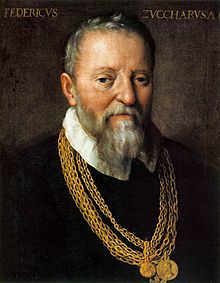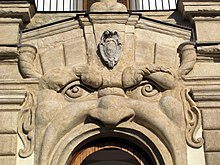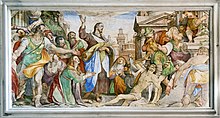Federico Zuccari

Federico Zuccari or Federico Zuccaro (* approx. 1540 in Sant'Angelo in Vado , † 1609 in Ancona ) was an Italian mannerist painter and art theorist .
life and work
Federico was the younger brother of the painter Taddeo Zuccari, born in Sant'Angelo in 1529 . He was his brother's student and later his colleague. Both of them worked in Rome for a long time and carried out commissions there, including for the Orsini , the Farnese , e. B. for Pope Paul III. Farnese. Between 1561 and 1565 he stayed in Veneto and Florence. The Grand Duke of Tosana Cosimo I called Zuccari to his court in Florence to finish the painting of the dome of Santa Maria del Fiore begun by Giorgio Vasari . After his brother's death in 1566, he completed the works he had begun in the Palazzo Farnese in Caprarola and the churches of Santa Trinità dei Monti and San Marcello al Corso in Rome.
Zuccari fled to London in 1574 because of an act of revenge . For the next six years, Zuccari worked mainly as a portrait painter at the English court. His best-known pictures from this period are the portraits of the queens Elizabeth I and Maria Stuart .
From 1580 he was on behalf of Pope Gregory XIII. involved in the painting of the Cappella Paolina , the smaller palace chapel in the Vatican. In 1581 he was banished from Rome in the course of legal proceedings against him and was only allowed to return two years later to complete the work on the Cappella Paolina. Around 1586 he followed a call from King Philip II to Madrid to help design the Escorial . With a few exceptions, these were altarpieces and frescoes. During his stay in Spain, the illustrations for Dante's Divina Commedia were created , which are now in the Uffizi .
In 1591 Zuccari began building a residential building in Via Gregoriana in Rome, the Palazzo Zuccari , which was not completed during his lifetime. The portal to the then garden of the palace, a mascherone , has the shape of a face with a huge open mouth. Zuccari painted the basement with frescoes.
When he returned to Rome in 1593 he founded the Accademia di San Luca together with Federico Borromeo , where the young artists were taught according to principles that he later laid down in his book on art theory. In 1598 he was elected the first head of the academy.
From 1605 to 1607 Zuccari worked for Carlo Emanuele I of Savoy in Turin. There he published his book Idea dei scultori, pittori ed architetti , in which he developed his art theory, which was shaped by the philosophy of Neoplatonism . His book is about the origins and principles of art. Artistic inspiration and imagination are divine gifts through which the artist is able to create things comparable to nature. The artist's ideas, conceptions and works go through processes that are comparable to the creations of nature. The disegno interno , the idea of the work of art, needs the disegno externo , the realization by the artist. By creating a new world based on his inner ideas, the artist enters into a competition with the nature created by God.
Casa and Palazzo Zuccari
The Casa Zuccari in Florence is used today by the Art History Institute in Florence , the Palazzo Zuccari in Rome by the Bibliotheca Hertziana , two art historical research institutes that belong to the Max Planck Society .
Works
- Frescoes in the Villa d'Este , Tivoli, together with Taddeo Zuccari
- The conquest of Tunis, fresco in the Sala Regia of the Vatican
- Ceiling painting in the Cappella Paolina, Vatican
- Angel fall , ceiling painting in the Cappella Pius V of the Vatican
- Adoration of the Magi, 1564, San Francesco della Vigna , Venice
- Cleansing the Temple, 1571, altarpiece in Santa Caterina dei Funari , Rome
- The Doge's kiss before Pope Alexander III. in the porch of San Marco , Venice
- Submission of Barbarossa to the Pope, around 1582, Sala del Maggior Consiglio, Doge's Palace , Venice
Fonts
- L'Idea de'scultori, pittori e architetti . Turin 1607.
literature
- Christina Acidini Luchinat: Taddeo e Federico Zuccari, fratelli pittori del cinquecento. Milan 1999.
- Matthias Winner , Detlef Heikamp (ed.): The painter Federico Zuccari. A Roman virtuoso of European fame. Hirmer, Munich 1999.
- Julian Brooks: Taddeo and Federico Zuccaro. Artist-brothers in Renaissance Rome. The J. Paul Getty Museum, Los Angeles 2008.
- Cristina Acidini, Elena Capretti (eds.): Innocente e calunniato. Federico Zuccari (1539 / 40-1609) e le vendette d'artista. Giunti, Florence 2009.
- Davide Tonti, Sara Bartolucci (eds.): Sacro e profano alla maniera degli Zuccari. Taddeo, Federico e Giovampietro Zuccari. Una dinastia di artisti Vadesi. Editrice Tipolitografia Vadese, Sant'Angelo in Vado 2010.
Individual evidence
- ^ Maria Donati Barcellona: Zuccari, Federico . In: Enciclopedia Dantesca , Rome 1970.
Web links
- Zuccari, Federico. In: Enciclopedie on line. Istituto della Enciclopedia Italiana, Rome. Retrieved January 5, 2019.
| personal data | |
|---|---|
| SURNAME | Zuccari, Federico |
| ALTERNATIVE NAMES | Zuccaro, Federico |
| BRIEF DESCRIPTION | Italian mannerist painter and art theorist |
| DATE OF BIRTH | around 1540 |
| PLACE OF BIRTH | Sant'Angelo in Vado |
| DATE OF DEATH | 1609 |
| Place of death | Ancona |



